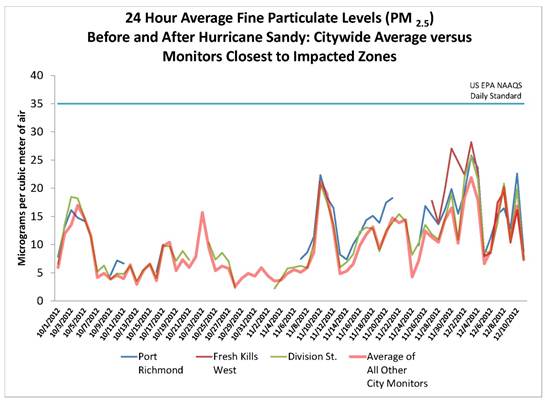FOR IMMEDIATE RELEASE 12-97 December 13, 2012 CONTACT: DEC: Emily DeSantis, 518-402-8000 State Adds New Air Monitors to Neighborhoods Hardest Hit by Hurricane SandyOngoing Monitoring Shows New York City Air Within Federal Health Standards, Normal for This Time of Year
The New York State Department of Environmental Conservation (DEC) today joined the New York City Department of Environmental Protection (DEP) and the New York City Department of Health and Mental Hygiene (DOHMH) to announce that the state has added three additional air monitoring units in the New York City neighborhoods hardest hit by Hurricane Sandy. The monitors will measure fine particulate matter (PM2.5) to provide data on the potential impact Hurricane Sandy recovery efforts have had on air quality. To date, the state’s network of rooftop air monitors does not reveal a pattern of higher concentrations since Hurricane Sandy and DEP’s testing of asbestos at debris piles have also come back negative. PM2.5 is the pollutant associated with dust, construction debris and the combustion of fuel. PM2.5 levels across the city vary each day with changes in the weather. Monitoring results since Hurricane Sandy show PM2.5 have been typical for this time of year and have not exceeded the federal standard of 35 micrograms of particulates per cubic meter of air based on a 24-hour average, the level at which air quality health advisories are generally issued. “While DEC’s ambient air monitoring network shows overall air quality has remained consistent with pre-hurricane conditions, we know residents are concerned,” DEC Commissioner Joe Martens said. “These three monitors will be placed in communities hardest hit by the storms, providing data on a near real-time basis.” “As the clean-up from Sandy continues, we are working closely with our City and State partners to monitor outdoor air quality particularly in areas where debris is being collected,” said DEP Commissioner Carter Strickland. “The addition of three new ambient air monitors in the hardest hit neighborhoods should reassure New Yorkers that the City and State will continue to monitor air quality throughout the clean-up and rebuilding.” “From routine monitoring of outdoor air, we know that the city’s overall air quality since Hurricane Sandy has been typical for this time of year,” said DOHMH Commissioner, Dr. Thomas Farley. “But essential cleanup and reconstruction work can produce additional street dust and emissions in communities most impacted by the storm. We’re pleased to be working with DEC to monitor outdoor air quality in these communities, share the data with the public, and inform agencies involved in the reconstruction and efforts to control dust and emissions where possible.” Data from DEC’s air monitoring network are available in near real time here and summarized in the table below.
In addition to their regular ambient air monitoring network, this week DEC has put in place three additional ambient PM2.5 air monitors at:
Data from these monitors will be available on DEC’s website when they become operational, which is expected by Friday. DEC is in the process of connecting its computer system to the new air monitors. As soon as this connection is established and functioning, data will be available. DEC will monitor the data in partnership with DOHMH, state Department of Health and DEP to determine if any further action is warranted. DEP has also monitored asbestos in construction debris, which could represent a health threat in the air. DEP sampled for asbestos at the most likely areas where it would be found, including the temporary staging areas for debris removal at Midland Beach and Riis Park. Asbestos fibers have not been detected in the vast majority of samples, and were far below health standards in the few samples where they were found. These results are available at here. DEP will continue to monitor for asbestos at the staging areas until they are no longer used for debris removal. To monitor outdoor air in areas affected by large-scale debris removal, DOHMH has taken air samples from areas in the Rockaways and Staten Island and tested them for PM2.5. The samples showed PM2.5 concentrations comparable to levels seen in prior DOHMH monitoring near outdoor grilling and high traffic density, and the city is taking steps to tamp down dust in these reconstruction areas. DOHMH has also created a Sandy Health Portal with information about outdoor air quality and other health issues. DOHMH and the State Health Department continue to urge New Yorkers to protect themselves from dust and mold when cleaning out storm-damaged homes by wearing an N95 dust mask, which is available for free at the City’s Restoration Centers and for sale at supply, home improvement and hardware stores. Additional information on mold and suggested mold cleanup tips can be found here. Previously, DEC operated three monitors in communities surrounding Floyd Bennett Field, including Gerritsen Beach and Mill Basin to the north and the Rockaways to the south. These monitors were installed to monitor ambient air quality while a test, enclosed burn of woody debris resulting from the storm was conducted at Floyd Bennett Field. All readings were in compliance with federal standards. The Lower Manhattan Construction Command Center (LMCCC) also maintains an air quality monitoring program to assess the cumulative impact of all Lower Manhattan construction projects. The LMCCC is conducting daily air monitoring at the following sites throughout Lower Manhattan: 292 Greenwich Street, 80 Catherine Street, 1 World Financial Center and 154 Nassau Street. Daily air quality reports are available here | ||
